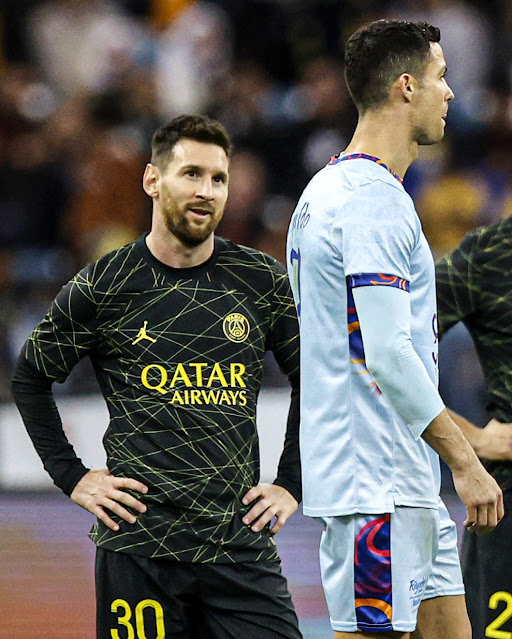FOOTBALL
RULES OF FOOTBALL
Football, also known as soccer in some countries, is a globally popular sport with a set of detailed rules that govern how the game is played. The rules are maintained and updated by the International Football Association Board (IFAB). Here is an overview of the key rules in football:
1.The Field of Play:The field is rectangular, with dimensions typically ranging from 100-110 meters (length) and 64-75 meters (width).
The field is marked with lines for the goal areas, penalty areas, center circle, and other designated areas.
The goals are positioned at the center of each goal line, with a net that extends behind the goalposts.
2.The Ball:
The ball must be spherical and made of leather or other approved materials.
It should have a circumference of 68-70 centimeters and a weight of 410-450 grams.
3.The Players:
Each team consists of 11 players, including one goalkeeper.
Substitutions are allowed, and players can be substituted in and out during specified stoppages.
4.Offside:
A player is in an offside position if they are closer to the opponent's goal line than the ball and the second-to-last defender when the ball is played to them.
It is not an offside offense to be in an offside position; it becomes an offense only when a player becomes involved in active play by gaining an advantage from the position.
5.Scoring a Goal:
A goal is scored when the entire ball crosses the goal line between the goalposts and under the crossbar.
The team with the most goals at the end of the match is the winner.
6.Fouls and Misconduct:
Players can be penalized for various fouls, including tripping, pushing, holding, and tackling from behind.
The severity of fouls can result in different disciplinary actions, including free kicks, penalty kicks, yellow cards (cautions), and red cards (sending off).7.Free Kicks:
Free kicks are awarded when a foul occurs. They can be direct (a goal can be scored directly from the kick) or indirect (another player must touch the ball before a goal can be scored).
The opposing players must be at least 9.15 meters (10 yards) away from the ball during a free kick.
8.Penalty Kicks:
A penalty kick is awarded when a foul occurs inside the penalty area. It is taken from the penalty spot, 11 meters (12 yards) from the goal line.
Only the goalkeeper is allowed to defend the penalty kick, and all other players must remain outside the penalty area.
9.Throw-Ins:
A throw-in is awarded when the ball goes out of play over the touchline. The throw-in is taken by the team that did not touch the ball last before it went out of play.
10.Goal Kicks and Corner Kicks:
A goal kick is awarded when the ball goes out of play over the goal line, and the last touch was by an attacking player. It is taken from inside the six-yard box.
A corner kick is awarded when the ball goes out of play over the goal line, and the last touch was by a defending player. It is taken from the corner arc closest to where the ball went out.
These are just some of the key rules in football. The complete Laws of the Game, as maintained by IFAB, provide a comprehensive guide to all aspects of the sport, including match officials, duration of matches, and additional rules and regulations.
DETAILS ABOUT THE TEAMS IN FOOT BALL
Football, also known as soccer in some parts of the world, is a team sport played between two teams of eleven players each. The objective of the game is to score goals by getting the ball into the opponent's goal while following a set of rules and regulations. Here are some details about the teams in football:
Formation: Football teams typically use a formation that dictates the positioning of players on the field. Common formations include 4-4-2, 4-3-3, and 3-5-2, which indicate the number of defenders, midfielders, and forwards in each line.
Players' Positions: Each player has a specific role and position on the field. The positions are divided into four main categories:
Goalkeeper: The player who defends the team's goal and prevents the opposing team from scoring.
Defenders: Players who primarily focus on preventing the opposing team from advancing and scoring. Positions include center-backs, full-backs, and wing-backs.
Midfielders: These players control the midfield, distributing passes, creating opportunities, and providing defensive support. Positions include central midfielders, defensive midfielders, and attacking midfielders.
Forwards: Players responsible for scoring goals and creating goal-scoring opportunities. Positions include strikers and wingers.
Captain: Each team designates a captain who is responsible for leading the team, making decisions on the field, and representing the team during interactions with match officials.
Substitutions: Teams are allowed to make substitutions during the game to replace players with fresh ones or adjust tactics. Substitutes can enter the game when the ball is out of play.
Tactics: Teams employ various tactics and strategies to gain an advantage over their opponents. This includes passing, dribbling, pressing, and positioning to control possession, create chances, and defend effectively.
Home and Away: In competitive matches, one team is designated as the home team, and the other is the away team. The home team plays in its own stadium, while the away team travels to the opponent's venue.
Jerseys and Colors: Teams wear distinctive jerseys or uniforms to identify themselves on the field. The colors and designs often represent the club's identity and history.
Manager and Coaching Staff: Each team has a manager (head coach) who is responsible for selecting the starting lineup, making tactical decisions, and guiding the team's overall strategy. The coaching staff includes assistant coaches, analysts, and other support personnel.
Competitions: Football teams participate in various competitions, including domestic leagues, cup competitions, and international tournaments. Examples of top domestic leagues include the English Premier League, La Liga, Serie A, Bundesliga, and Ligue 1.
Rivalries: Many football teams have intense rivalries with other clubs, often based on historical, regional, or cultural factors. These matches, known as derbies, elicit strong emotions among fans and players.
Football teams have a global fan base and contribute to the rich history and culture of the sport. The teamwork, individual skills, and strategic gameplay exhibited by these teams make football one of the most popular and beloved sports worldwide.


%20(1).jpg)
.jpg)

.jpg)

%20(2).jpg)
.jpg)
.jpg)



